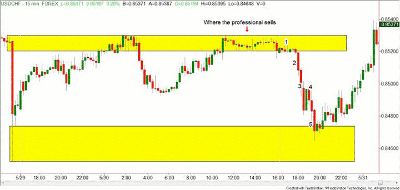The ability to recognize important supply and demand levels on the charts and take quick, decisive action often separates the 10% of traders who succeed from the 90% who fail.
Looking back at some of the trading mistakes I've made (and the mistakes others have made when they first began), it was easy to see how experienced traders took advantage of us. The same holds true today.
In every class I teach, we can see the mistakes that the novice trader (the “90%-er,” since 90% of traders lose money) makes. The question always comes up, "Who is buying way up there? It's so expensive now!"
The answer is that the 90%-er is buying the expensive stock/future/currency pair. And who are they buying from? The “10%-er,” or the traders who consistently make money from trading.
So the next question is why are they buying there? The simple answer is because they don't understand the importance of supply and demand levels. The more complicated answer is that they are waiting for more confirmation that this particular level will hold…often too much confirmation.
Let's take a look at a chart and go through the common thought process of a 90%-er. On the USD/CHF chart below, I've drawn in an easy supply zone and a difficult demand zone.
The supply zone is easy because of the strength of the moves away from it. The demand zone is difficult because of its width. I chose the bottom portion of the tail of the long red candle, ending at the low point of the next green candle.
In a future article, we'll discuss different techniques for defining your supply and demand zones. The professional trader will sell at the supply zone because of the supply/demand imbalance; notice the strength of the moves away from the level.
Where will the novice trader sell? After a significant portion of the last downtrend has already happened! Here is their thought process at each labeled number:
- “I can't sell now, it was just going up! What if it keeps going up? Maybe this is just a pause; I don't want to take another loss!”
- “OK, it's starting to go down, but I've made this mistake before! No way am I selling this breakdown! They will just turn this thing up and stop me out!”
- “Oh man, this thing is still going down; I knew I should have sold it earlier! Maybe I should sell now? Let me check the chart to see how far this thing will go…”
- “See the bounce! Good thing I didn't sell! I knew it was going to go back up; they were playing games with me!”
- “Drat, looks like it will keep going down. I knew I should have sold it earlier! Alright, time to join this trend, time to sell!”
And that's when the professional traders buy.
So, what is the novice trader doing wrong? They are waiting for too much confirmation!
We must always have in mind all three parts of our trade before we hit the button: Our entry, stop-loss price, and profit target. If you don't have all three figured out ahead of time, you are doing it wrong.
The longer you wait in the trend to enter your trade, the larger your stop gets and the smaller your profit target gets. That is wrong.
The more time you spend learning to trust the levels you have drawn, the more they may help get you into trades earlier with a much better reward-to-risk ratio. These are some of the secrets to trading well.
By Rick Wright, instructor, Online Trading Academy






















